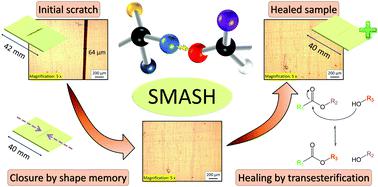当前位置:
X-MOL 学术
›
Polym. Chem.
›
论文详情
Our official English website, www.x-mol.net, welcomes your
feedback! (Note: you will need to create a separate account there.)
Shape memory-assisted self-healing of dynamic thiol-acrylate networks
Polymer Chemistry ( IF 4.1 ) Pub Date : 2021-09-21 , DOI: 10.1039/d1py00925g Walter Alabiso 1 , Tiago Manuel Hron 2 , David Reisinger 1 , Daniel Bautista-Anguís 1 , Sandra Schlögl 1
Polymer Chemistry ( IF 4.1 ) Pub Date : 2021-09-21 , DOI: 10.1039/d1py00925g Walter Alabiso 1 , Tiago Manuel Hron 2 , David Reisinger 1 , Daniel Bautista-Anguís 1 , Sandra Schlögl 1
Affiliation

|
Self-healing polymers are tremendously attractive due to their ability to repair macroscopic damage and defects, thus opening doors to sustainable and reliable functional polymers. In this scope, vitrimers are in the spotlight, as dynamic polymer networks exhibiting unique properties such as self-healing ability, recyclability and malleability. The possibility of intrinsically healing macroscopic damage on the molecular scale repeatedly is undoubtedly appealing, although it would strongly benefit from an additional driving force bringing the surfaces of larger defects together. Herein, we present a study on the synergistic combination of physical and chemical healing of a thiol-acrylate vitrimeric photopolymer based on thermo-activated transesterification by pursuing a close-then-heal approach. By following shape-memory assisted self-healing (SMASH), we used the shape-memory properties of thiol-acrylate photopolymers to physically close a scratch, whilst chemical healing was obtained via thermo-activated dynamic exchange reactions of the –OH groups and ester moieties available in the network. We prepared formulations with varying thiol content and characterised their mechanical, chemical, and shape memory properties and healing efficiency. We provide a comprehensive picture of the role of physical recoil, bond exchanges and network mobility on self-healing efficiency as well as its limitations. By appropriate network design, defects with a size of 50–150 μm can be rapidly closed, and healing efficiency up to 90% can be reached in terms of ultimate tensile strength, thus demonstrating the potential of SMASH for vitrimers.
中文翻译:

动态硫醇-丙烯酸酯网络的形状记忆辅助自修复
自修复聚合物因其修复宏观损伤和缺陷的能力而极具吸引力,从而为可持续和可靠的功能聚合物打开了大门。在这个范围内,玻璃体是聚光灯下的焦点,因为动态聚合物网络表现出独特的性质,如自愈能力、可回收性和延展性。在分子尺度上反复进行内在修复宏观损伤的可能性无疑是有吸引力的,尽管它会极大地受益于将较大缺陷的表面聚集在一起的额外驱动力。在本文中,我们通过追求关闭然后愈合的方法,对基于热活化酯交换的硫醇-丙烯酸酯玻璃体光聚合物的物理和化学愈合的协同组合进行了研究。通过网络中可用的 –OH 基团和酯部分的热激活动态交换反应。我们制备了具有不同硫醇含量的制剂,并表征了它们的机械、化学和形状记忆特性以及愈合效率。我们全面介绍了物理反冲、债券交换和网络移动性对自愈效率及其局限性的作用。通过适当的网络设计,可以快速闭合50-150μm的缺陷,极限拉伸强度方面的愈合效率可以达到90%,从而证明了SMASH在玻璃体方面的潜力。
更新日期:2021-09-27
中文翻译:

动态硫醇-丙烯酸酯网络的形状记忆辅助自修复
自修复聚合物因其修复宏观损伤和缺陷的能力而极具吸引力,从而为可持续和可靠的功能聚合物打开了大门。在这个范围内,玻璃体是聚光灯下的焦点,因为动态聚合物网络表现出独特的性质,如自愈能力、可回收性和延展性。在分子尺度上反复进行内在修复宏观损伤的可能性无疑是有吸引力的,尽管它会极大地受益于将较大缺陷的表面聚集在一起的额外驱动力。在本文中,我们通过追求关闭然后愈合的方法,对基于热活化酯交换的硫醇-丙烯酸酯玻璃体光聚合物的物理和化学愈合的协同组合进行了研究。通过网络中可用的 –OH 基团和酯部分的热激活动态交换反应。我们制备了具有不同硫醇含量的制剂,并表征了它们的机械、化学和形状记忆特性以及愈合效率。我们全面介绍了物理反冲、债券交换和网络移动性对自愈效率及其局限性的作用。通过适当的网络设计,可以快速闭合50-150μm的缺陷,极限拉伸强度方面的愈合效率可以达到90%,从而证明了SMASH在玻璃体方面的潜力。











































 京公网安备 11010802027423号
京公网安备 11010802027423号